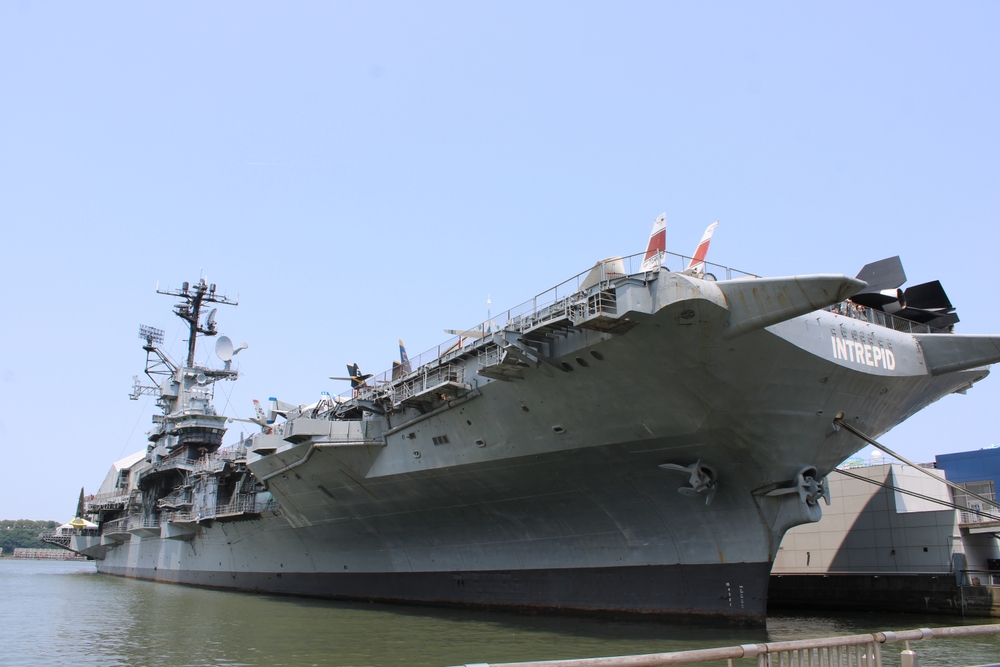The USS Intrepid (CV-11/CVA-11/CVS-11) was one of 24 Essex-class aircraft carriers ordered by the U.S. Navy and served as part of the Pacific Fleet during World War II, as well as in the Mediterranean and Vietnam. As was true of almost all ships built between the 1930s and 1980s, the Intrepid’s structure, as well as its equipment and supplies, included significant amounts of asbestos. Navy veterans who served on the ship, as well as shipyard workers who maintained and repaired her, are at risk for malignant mesothelioma, asbestosis, and other asbestos-related illnesses.

About the USS Intrepid
Today, the USS Intrepid is best known for its second life as a memorial, museum ship, and National Historic Site,[1] but the ship was one of the Essex-class of aircraft carriers that represented the most numerous class of capital ships built for the U.S. Navy during the 20th century.[2]
The Essex class of aircraft carriers was the result of the U.S. Navy recognizing the value that flight would have in naval operations. There were eight different classes of carriers designed and built between 1910 and the 1940s when the Essex was authorized and produced, and it represented the culmination of constant improvement. The Intrepid was the third vessel built of the class, and like her sister ships, she served as a mobile air base for fighter jets, scout planes, and support planes.[1]
First ordered in July 1940, the Intrepid was laid down at Newport News Shipbuilding in December 1941, launched in April 1943, and commissioned later that same year. Decommissioned after World War II ended, she was modernized and recommissioned in 1954, at which time she was redesignated as an attack carrier. Over the years, she underwent several improvements and overhauls, including receiving an angled deck in 1956 and being redesignated again as an anti-submarine carrier in 1965.[3] In addition to her military deployments, the Intrepid was also designated the recovery ship for two space missions.
The Intrepid measured 872 feet long and displaced 36,960 long tons when fully loaded. She was powered by four Westinghouse geared steam turbines and eight Babcock & Wilcox boilers and carried a full complement of 2,630 sailors and officers. When full, its flight deck with island and hangar deck held up to 100 aircraft.[3]
Service and Deployment
The USS Intrepid played a significant role in the Pacific Theater during World War II, participating in several major campaigns from when it launched in 1943 to the end of combat in 1945. The ship participated in the Marshall Islands invasion and joined the raid on Truk, helping destroy significant Japanese shipping resources. A particularly notable incident occurred in February 1944 when, after torpedo damage jammed her rudder, the ship’s crew improvised a sail made from hatch covers and canvas to help maintain course control until she could reach Pearl Harbor for repairs. She then returned to conduct strikes in the Palaus and Philippines. Intrepid played a crucial role in the Battle of Leyte Gulf, where the aircraft that called her decks home helped sink the battleship Musashi and damaged several other major Japanese vessels. At the end of her first full year of combat, she suffered two kamikaze hits but was able to continue operations.[4]
In the final year of the war, the Intrepid’s crew continued making invaluable contributions to the Allied efforts in the Pacific, conducting strikes against mainland Japan, including raids on Kyushu and supporting the Okinawa invasion. In April, she suffered another kamikaze hit to her flight deck but participated in the final operations of the war, including strikes on Wake Island and supporting the occupation of Japan before returning to the United States in December.[4]
After World War II, Intrepid underwent several major transformations and served in a number of roles. After being decommissioned in 1947 and placed in the Pacific Reserve Fleet, she was recommissioned and converted into a modern attack carrier. She became the first aircraft carrier to use American-built steam catapults, served two Mediterranean deployments with the 6th Fleet, and participated in NATO’s Operation Strikeback, as well as conducting multiple operations along the Atlantic coast. In the 1960s, she was converted to an anti-submarine warfare support carrier (CVS-11), after which she played key roles in NASA missions, recovering astronaut Scott Carpenter after the Project Mercury mission and astronauts Grissom and Young after the Gemini 3 flight.[4]
The Intrepid returned to combat duty in the mid-1960s when she was deployed to Vietnam with the Pacific Fleet. During that war, she distinguished herself by setting records for rapid aircraft launching and completing successful combat operations. She was deployed again to Western Pacific via Suez Canal in 1967, then began another tour with the Seventh Fleet. By 1969, Intrepid was back at her home port, and in 1971, took part in NATO exercises that saw her calling in multiple ports in the Mediterranean and the Baltic through 1974, when she was decommissioned.[4]
After being used to host exhibits at the Philadelphia Naval Shipyard as part of the U.S. Bicentennial celebration, plans for her to be scrapped were canceled by a campaign to establish her as a museum ship. After several years of fundraising, the ship was opened at Pier 86 in Manhattan as the Intrepid Sea, Air & Space Museum and was officially designated as a National Historic Landmark in 1986.[4]
Was the USS Intrepid Built Using Asbestos?
Asbestos was a primary material of choice for naval construction from the 1930s due to a remarkable combination of qualities that made it popular in many other industries as well. It provided excellent insulation against heat, resisted fire — important for a ship that carried aviation fuel — and was readily available at a low cost. These characteristics made it particularly appealing to the U.S. military, especially for ships operating at sea where fire prevention and heat management were critical concerns. Notably, the ship was constructed at the Newport News Shipyard, which is known today as a notorious user of asbestos in its shipbuilding.
The Intrepid, like many other U.S. Navy aircraft carriers of her era, incorporated substantial amounts of asbestos in her construction. This widespread use had tragic consequences for both the Navy veterans who served onboard the ship and the shipyard workers who handled maintenance and repairs on the ship over the years. Decades later, many of these individuals have developed serious and deadly health conditions, including malignant mesothelioma, asbestosis, and others that are directly related to asbestos exposure.
On the USS Intrepid, asbestos was a component of:
- Adhesives
- Boiler and engine rooms
- Caulk
- Deck coverings
- Electrical coating
- Engines
- Pipe insulation
- Valves
- Lagging and rope
- Lining of wall plates and doors
- Paint
- Pumps
- Gaskets
- Flooring and ceiling materials
- Fireproofing materials
- Firefighting gear
Exposure and Illness in Veterans Who Served on the Intrepid
The presence of asbestos aboard the USS Intrepid created serious health hazards for Navy personnel, who were exposed to the mineral in multiple ways. When asbestos fibers are disturbed or damaged, they become airborne (or friable), creating an invisible but deadly risk of inhalation. When these microscopic fibers’ needle-like ends become trapped in the cells of the organ that lines the cavity where the lungs or abdominal organs are located, it is nearly impossible for the body to expel them. Over decades, they cause irreparable damage, including scarring and mutating into mesothelioma tumors.
Asbestos fibers were released in multiple circumstances, from routine maintenance work to normal wear and tear. The violent motions that are inherent with sea voyages and the vibrations from planes taking off and landing also caused it to deteriorate, putting personnel working in certain areas of the ship at high exposure risk.
Though everybody onboard the Intrepid was endangered by the presence of asbestos, those assigned to the engine and boiler rooms or tasked with maintenance duties were at particular risk. Over time, this exposure has led to severe health complications for many veterans, including mesothelioma, lung cancer, asbestosis, and scarring of lung tissue.
Responsibilities aboard the USS Intrepid that posed the highest risk of asbestos exposure included:
- Boiler workers
- Pipefitters
- Insulation workers
- Maintenance workers
- Engine room workers
- Firemen
- Shipyard workers performing repairs
Many cases of asbestos-related illnesses have been linked to having served aboard the USS Intrepid. These include:
- Martin “Marty” Russian, a veteran who joined the Navy in 1956 at the age of 17. He spent three years on the Intrepid as a machinist mate, removing and installing asbestos-containing insulation, gaskets, and packing from pumps throughout the ship. He was also exposed to asbestos on the clothing of shipmates who were working with asbestos-contaminated lagging and insulation from steam pipes, boilers, forced draft blowers, and other machinery onboard the ship. Decades later, he developed malignant mesothelioma and, together with his wife, filed a personal injury lawsuit against the asbestos companies that supplied the toxic material to the ship.
- In 2009, a Los Angeles County jury awarded $1.4 million in damages to the widow of a Navy veteran who developed mesothelioma after having served on the USS Intrepid and other ships maintaining, repairing, and overhauling pumps, valves, and mechanical systems within naval steam propulsion systems. Testimony in the trial noted his daily 8-10 hour shifts, which exposed him to enormous concentrations of asbestos in small, unventilated areas.[5]
- A lawsuit was filed by Michael J. and Anna McCurdy after he was diagnosed with malignant mesothelioma. Mr. McCurdy had joined the Naval Reserves in 1967 and was assigned to the Intrepid in 1969, in dry dock. While onboard, he worked as a machinist mate in the engine room, replacing asbestos-containing gaskets and packing made by Garlock Sealing Technologies and other companies and working on turbines manufactured by Westinghouse. He was exposed to those asbestos-containing turbines that were opened following the Intrepid’s having run aground. In 2007, Mr. McCurdy was diagnosed with malignant mesothelioma.[6]
Did You Serve on the USS Intrepid?
If you are a Navy veteran who served on the USS Intrepid, exposure to asbestos is a very real concern, as the material was used throughout the ship’s infrastructure and was included in many of its components. The health risks from this type of exposure are not in the past, despite decades having passed: Asbestos-related diseases have very long latency periods and often take decades to develop.
With asbestos-related diseases having such long-term health implications, veterans who served on the Intrepid need to speak to their physicians and make sure they understand the urgency of prioritizing medical monitoring and early screening. Though asbestos-related diseases can be mistaken for other, more benign conditions, when they are identified early, you have a better chance of receiving more effective treatment.
Veterans diagnosed with asbestos-related illnesses have several options available to them. Starting with the benefits available through the Veterans Administration (VA), you may be eligible to have your healthcare costs covered, as well as receiving additional financial and emotional support specifically designed to assist you in dealing with service-related health conditions.
Beyond benefits from the VA, many veterans have successfully pursued compensation through the justice system by taking legal action against the companies that manufactured and supplied asbestos-containing materials to the Navy. You may also be able to take action against employers you worked for after your military service.
A skilled and experienced mesothelioma attorney can help you identify the companies that provided asbestos to the Intrepid during the period when you served. They will also explain your legal options, which may include filing a personal injury lawsuit. These actions may result in a jury trial but more often lead to out-of-court settlements with substantial compensation. Many veterans have secured multi-million-dollar awards.
You may also be eligible to file a claim for compensation from the asbestos trust funds that bankrupt companies with asbestos liabilities were required to establish. While these funds generally offer lower payouts than lawsuits, they provide faster resolutions and immediate financial relief.
Making an appointment to speak with an asbestos attorney soon after your diagnosis ensures you have the most time to explore all the options available to you.
References
- National Park Service. (N.D.). USS Intrepid.
Retrieved from: https://www.nps.gov/articles/uss-intrepid.htm - Seaforces. (N.D.). Essex class Aircraft Carrier – CVA/CV
Retrieved from: https://www.seaforces.org/usnships/cv/Essex-class.htm - NavSource Online: Aircraft Carrier Photo Archive. (N.D.). USS Intrepid (CV-11)
Retrieved from: https://www.navsource.org/archives/02/11.htm - Naval History and Heritage Command. (N.D.). USS Intrepid.
Retrieved from: https://www.history.navy.mil/our-collections/photography/us-navy-ships/alphabetical-listing/i/uss-intrepid–cv-11-cva-11-cvs-11-0.html - WKPS. (April 24, 2009.). U.S. Navy Widow Awarded $1.4M in Long-Term Asbestos Exposure Case.
Retrieved from: https://www.waterskraus.com/louisiana/u-s-navy-widow-awarded-1-4m-in-long-term-asbestos-exposure-case/ - Casetext. (June 18, 2013.). McCurty v. John Crane-Houdaille, Inc.
Retrieved from: https://casetext.com/case/mccurdy-v-john-crane-houdaille

Terri Heimann Oppenheimer
WriterTerri Oppenheimer has been writing about mesothelioma and asbestos topics for over ten years. She has a degree in English from the College of William and Mary. Terri’s experience as the head writer of our Mesothelioma.net news blog gives her a wealth of knowledge which she brings to all Mesothelioma.net articles she authors.

Dave Foster
Page EditorDave has been a mesothelioma Patient Advocate for over 10 years. He consistently attends all major national and international mesothelioma meetings. In doing so, he is able to stay on top of the latest treatments, clinical trials, and research results. He also personally meets with mesothelioma patients and their families and connects them with the best medical specialists and legal representatives available.


